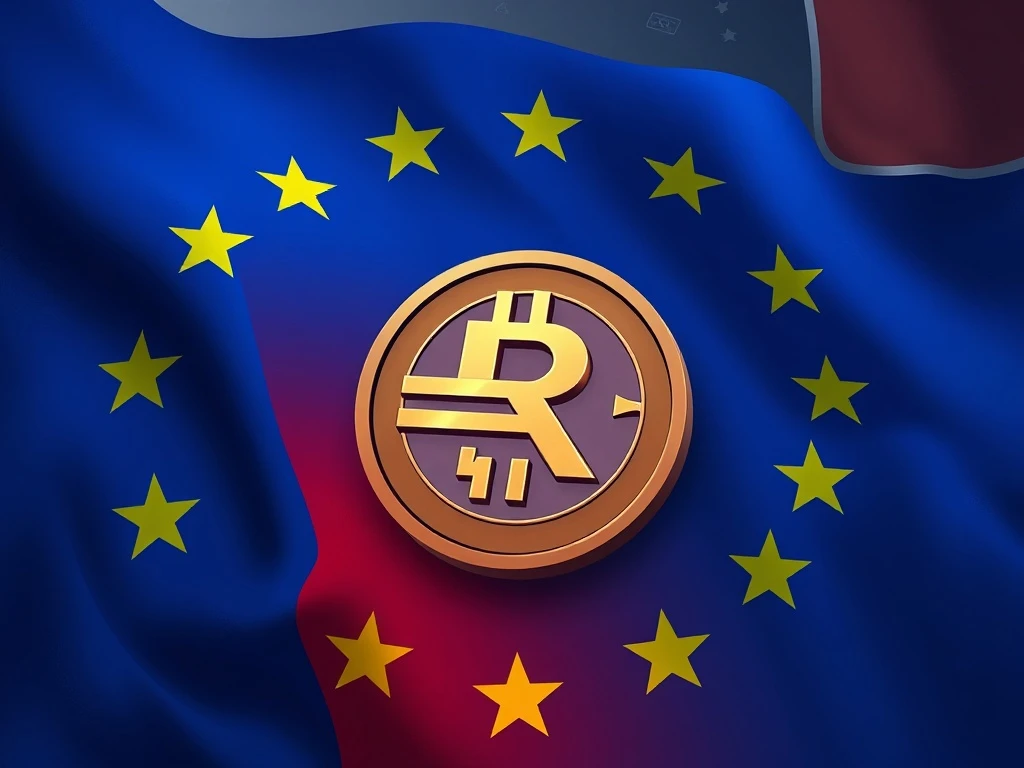EU Sanctions Threaten A7A5: A Critical Blow to Russia’s Crypto Evasion

The cryptocurrency world often operates at the intersection of innovation and geopolitics. Presently, a significant development is unfolding as the European Union reportedly considers imposing **EU sanctions** on **A7A5**, a prominent **ruble-backed stablecoin**. This potential move marks a critical escalation in the ongoing efforts to restrict Russia’s access to global financial systems, particularly concerning **Russia crypto** activities and methods of **financial evasion**. The implications for the digital asset landscape are substantial.
The Looming Threat of EU Sanctions on A7A5
According to recent reports, the European Union is actively weighing a prohibition on **A7A5**. This proposed ban would prevent all EU-based entities and individuals from engaging directly or indirectly with the token. Such a measure targets the world’s largest non-US-dollar pegged stablecoin. Furthermore, several banks in Russia, Belarus, and Central Asia face scrutiny. These institutions are allegedly enabling sanctioned entities to conduct various **crypto-related transactions**. This latest initiative by the EU aims to further restrict Russian-tied crypto movements. Previously, on September 19, the EU implemented sanctions blocking all transactions for Russian residents on crypto platforms. They also restricted dealings with foreign banks linked to Russia’s financial sector. This current proposal signals a deepening commitment to disrupting Russia’s financial maneuvers.
Russia’s Expanding Financial Evasion Tactics
Cryptocurrency represents merely one avenue Russia utilizes to circumvent Western penalties. Global risk consultancy firm Integrity Risk International highlights a range of other sophisticated methods. For instance, Russia employs a ‘shadow fleet’ of hundreds of vessels. These ships smuggle sanctioned goods, obscuring the origins of its oil. Intermediary trading through other nations also plays a crucial role in these **financial evasion** strategies. Moreover, a December 2024 report by the global policy think tank Rand indicated Russia’s use of illicit gold trades for money laundering. These diverse tactics demonstrate a concerted effort to maintain economic fluidity despite international pressure. Specifically, Russia’s **financial evasion** includes:
- Shadow Fleet: Hundreds of vessels used for smuggling sanctioned goods and concealing oil origins.
- Intermediary Trading: Conducting transactions through other countries to bypass direct sanctions.
- Illicit Gold Trades: Employing gold for money laundering activities.
- Cryptocurrency: Utilizing digital assets like **A7A5** for cross-border transactions.
The EU’s focus on **A7A5** underscores the growing importance of digital assets in this complex geopolitical landscape.
A7A5: Russia’s Ruble Stablecoin Under Scrutiny
The **A7A5 ruble stablecoin** has drawn considerable attention, especially given its market dynamics following previous sanctions. A week after the EU’s initial crypto platform sanctions on September 19, **A7A5’s market capitalization** experienced a dramatic surge. It jumped from approximately $140 million to over $491 million by September 26. This represented a remarkable 250% increase in just one day, according to CoinMarketCap data. As of Monday, **A7A5’s market capitalization** remains stable at around $500 million. This figure accounts for roughly 43% of the total $1.2 billion market cap for all non-US dollar stablecoins. For comparison, Circle’s euro-pegged EURC ranks as the second-largest, with a market capitalization of about $255 million. The substantial size of **A7A5** makes it a significant target for the proposed **EU sanctions**. It highlights its perceived utility in **Russia crypto** operations.
Escalating Global Crypto Sanctions Targeting Russia’s Crypto Operations
For **EU sanctions** to be approved, they require the unanimous backing of all 27 member states. Furthermore, these proposals can undergo amendments or changes before their final implementation. The European Council defines sanctions as a tool designed to influence policies or actions. They aim to ‘bring about a change in the policy or conduct of those targeted.’ This process serves to promote the objectives of the EU’s Common Foreign and Security Policy. The EU’s consideration of these measures aligns with similar actions taken by other major global powers. Both the United Kingdom and the United States imposed analogous restrictions in August. These earlier **crypto sanctions** targeted parts of the financial sector allegedly used by Russia to bypass Western penalties. Specific entities included the Capital Bank of Central Asia and its director, Kantemir Chalbayev. Kyrgyzstan crypto exchanges Grinex and Meer were also blacklisted. These exchanges operate in a Central Asian country that issues **A7A5**. Additionally, entities supporting the **ruble-backed stablecoin’s** infrastructure were included in these blacklists, directly impacting **Russia crypto** capabilities.
The Origins and Controversies of A7A5
The **A7A5 ruble stablecoin** first launched in February. Moldovan banker Ilan Shor and Russia’s state-owned lender Promsvyazbank were behind its creation. It was initially promoted as a ‘token backed by a diversified portfolio of fiat deposits.’ These deposits were reportedly held in ‘reliable banks within Kyrgyzstan’s network.’ Despite the growing international scrutiny and a ban by Singapore, the company behind **A7A5** maintained a public presence. Notably, it appeared at Token2049, a major crypto conference. The company even hosted a booth, and executive Oleg Ogienko spoke on stage. However, the organizers subsequently removed the project from the event and their official website. This removal underscores the increasing pressure and controversy surrounding **A7A5** and its connections to **Russia crypto** activities. The incident reflects the delicate balance between promoting innovation and enforcing international financial regulations.
Implications for the Broader Crypto Ecosystem
The potential **EU sanctions** against **A7A5** carry significant implications beyond Russia itself. They signal a broader trend of regulatory bodies increasing their focus on stablecoins. Regulators aim to ensure these digital assets do not facilitate illicit financial flows or undermine global sanctions regimes. This development could prompt other jurisdictions to re-evaluate their approaches to non-USD pegged stablecoins. Consequently, it may lead to stricter compliance requirements across the entire crypto industry. The ongoing efforts to combat **financial evasion** using digital assets demonstrate a growing sophistication in regulatory oversight. As governments continue to adapt to the evolving digital financial landscape, crypto platforms and projects must prioritize transparency and adherence to international laws. This proactive approach will be crucial for maintaining trust and fostering sustainable growth within the crypto ecosystem.










